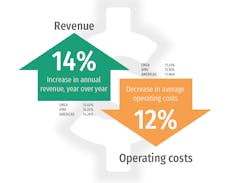Much like people who know on an intellectual level that they ought to improve their diet and exercise habits—yet fail to do so—many organizations fail to invest in IT innovation, despite recognizing the clear ROI of it.
A recent global survey of IT and finance leaders by independent research firm Vanson Bourne revealed that 90% thought their organizations ought to be spending more on innovation, and 77% said a major barrier to doing so was the burden of “keeping the lights on” IT spending—the maintenance of existing systems and IT infrastructure. In addition, 70% cited a lack of support for innovation from their current technology providers, and 63% said they feel locked into those relationships. In fact, 74% said vendor lock-in was one of the major barriers to innovation.
The survey is based on responses from 900 CIOs, IT leaders and financial decision makers from a broad range of industries including: manufacturing, retail, healthcare, petrochemicals, oil and gas; public sector, and high tech /telecoms. Manufacturing execs represented the third most number of respondents after high tech/telecoms and the public sector.
Here are some of the reasons survey participants gave for investing in IT—including IoT, artificial intelligence, the cloud, blockchain technology, virtual reality and technology and approaches to accelerate application development:
The ROI of IT Innovation
The impact on revenue alone ought to command attention. More than eight in 10 respondents (84%) said they experienced revenue increases as a result of spending on IT innovation—on average, a 14% increase in annual revenues, with the petrochemicals, oil and gas industries experiencing the highest return on investment.
Another way to achieve a return on investment is by reducing operational costs, and 85% said their organizations have achieved or expect to achieve a cost reduction. In manufacturing, that was 88% - with 42% saying they have already reduced operational costs through innovation.
For those who have realized a cost reduction, the average savings reported was 12%.
Closing the Gap
Why the mismatch between recognition of the benefits and willingness to invest? We can see some of the answers in what survey participants said about board level leadership. Half of respondents reported that they have been unable to convince their board of directors that investing in IT innovation is critical to the business. Moreover, 76% of respondents indicated a “lack of board support for significant investment in innovation.”
I think what this really tells us is that top company leaders are not confident that money spent on IT will translate into the kind of innovation that leads to an ROI. Changing that mindset requires a rebalancing of spending priorities.
In other words, if too much money is going to “keeping the lights on,” how can you change that? How can you demonstrate the financial discipline in the management of technology that will make the case for more investment?
Some survey participants are finding ways. Those from manufacturing were among the most likely (57%) to say they were shifting applications to the cloud and renegotiating enterprise technology vendor contracts (51%) as a way of reducing their “keeping the lights on” spending and directing more funding to innovation.
Furthermore, those from manufacturing are extracting more value from existing IT (60%) and using more open source software (32%), which supports the point that funding for IT innovation will come from both realignment and reinvestment in resources for respondents’ organisations.
Securing investment in transformational projects may not be easy, but it is worth the effort of breaking down the barriers to innovation in order to produce exceptional results.
The State of IT Innovation: A Global Survey of IT and Finance Decision Makers is based on responses from 900 CIOs, IT leaders and financial decision makers from a broad range of industries including: manufacturing; petrochemicals, oil and gas; public sector; healthcare; retail and high tech /telecoms
Hari Candadai is global vice president, global product marketing and strategy, at Rimini Street.






